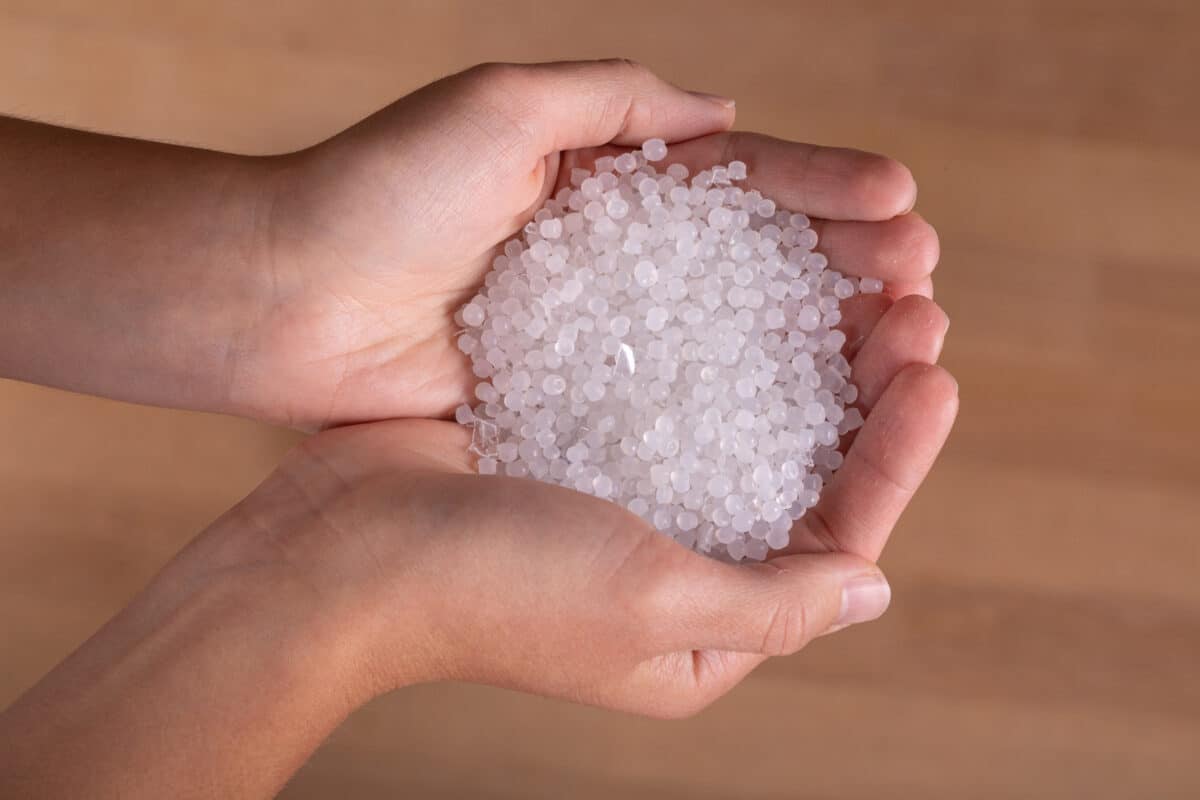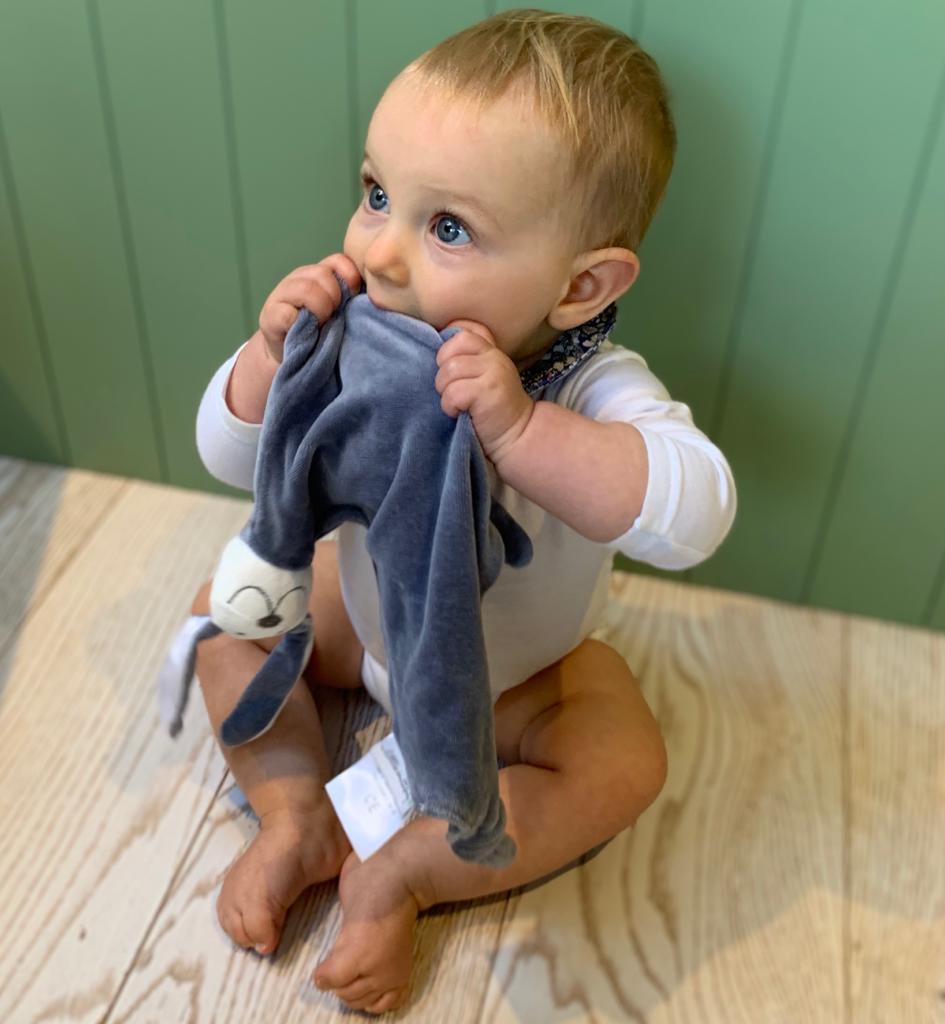

Why are babies more exposed to microplastics?
Microplastics have now made their way into all levels of our food chain, and also our household dust, air and children’s toys. Humans are exposed to these plastics from their diet, drinking water, dust and from the small particles which float in the air that we breath.
The New York School of Medicine has recently discovered that babies ingest 10-20x more microplastics than adults. Particularly PET plastics, which come from polyester textiles, water bottles and synthetic fabrics.
The study highlights that babies mouthing behaviour, sucking on polyester teddies, synthetic fabrics and plastic toys, is the likely cause of the drastically higher levels of PET plastics in their feces.
Microplastic in children’s products
Sadly, due to its durability and low cost, plastics are often the go-to material for children’s products.
The vast majority of soft toys sold in the UK are made from 100% polyester. Polyester is made from PET plastic, the same plastic type as water bottles. Hence ‘recycled’ polyester, which is usually made from water bottles. This so claimed ‘eco’ polyester has been found to be way worse for human health than virgin polyester as the recycling processing releases a significant amount more of the dangerous chemicals. It also still sheds toxic microplastics and, arguably, many more than would have been shed by the water bottle itself. Unfortunately, polyester plush (the fluffy fabrics often used for toys) sheds a lot more microplastics than tightly woven polyester yarns.
Polyester plush is also commonly used to make children’s fleeces, snowsuits, waterproof outerwear, blankets and much more.


Microplastics are a growing health concern
Microplastics in the human body are a growing health concern. Studies on animals and humans have found numerous toxic effects associated with high levels of microplastic ingestion, including: cell damage, hormone disruption, neuro toxicity, reproductive issues, cancer and obesity – to name a few.
This is likely due to the plastics themselves, but also the multiple chemicals which are added to the plastics during the production process, which are released from the plastics as they break down inside the body.
Pure Earth Collection’s #PlasticFreeBabies campaign
To help raise awareness and to show parents that simple swaps are achievable, we ran a “500 Bunny Giveaway” where we gave away organic bunny comforters to everyone who helped share information on the topic.

We also got in touch with DrKurunthachalam Kannan, Professor of Paediatrics and one of the lead researchers into microplastics and their effects on human health. Dr Kannan shared with us all the studies which have been done so far on the topic. From this, we condensed the information down into an 8 minute video to help parents have a better understanding and give solutions about how to cut back on household micro-plastics.
Help spread awareness
We strongly feel that more parents need to know about these studies so they can make informed choices about their children’s products – please share with your parent friends using one of the links below:
Tips to reduce microplastics in your home
Small changes make a big difference. Luckily, there are lots of things you can do which will really cut down the microplastics in your home and therefore your family’s exposure to these toxins:
- Avoid polyester teddies and choose cuddly toys made from cotton instead.
- If your child is already attached to certain polyester cuddlies, try to add in some cotton options too – hopefully over time they will form attachments with these new teddies and you can slowly phase out old favourites or suggest they sleep on chairs rather than in your child’s bed.
- Buy cotton or natural fabric clothing wherever you can, especially for your kids. Charity shops and hand-me-downs are great if you’re sticking to budgets, and an added benefit is that pre-loved clothes have less formaldehyde in the fabric due to all the previous washing.
- Remember that ‘eco’ or ‘recycled’ polyester is just as bad for your child’s health as virgin polyester, so avoid this too where possible.
- Swap out as much of the synthetic home textiles in your house as you can. Choose wool carpets with natural felt underlay, cotton or linen fabrics for sofas, cushions, throws and curtains.
- If you’re in rented accommodation, or not able to choose wool carpets for other reasons, don’t panic, there are still things you can do! Consider buying a natural fabric rug or mat and put this down over high traffic areas, and places where your kids are most likely to spend a lot of time.
- Hoover and dust your home regularly. Microplastics in your house collect in dust which young children are more exposed to than adults.
- Open windows everyday to help clean your household air. An air filter will also help remove small airborne micro-plastics.
- If you do have polyester items in your children’s wardrobe and can’t, or would rather not, swap them out, make sure your child doesn’t suck on the fabric and keep these fabrics away from their cots or beds.
- Always read the label to check what fabric you’re buying. Soft looking, velvety fabrics and faux fur are usually made from polyester. And many fabrics which claim to be ‘organic’ often have a high polyester blend.
Would you like to see polyester banned in kids items?
We want to help spread as much awareness as possible and we are thinking of campaigning for legislation to banning polyester plush fabrics in teddies and children’s blankets and clothing. If you’re keen for us to do this, please express your interest below. If enough of you are keen, we’ll start a government petition.
If you’re looking for some quick plastic-free solutions for your homes then check out our product, made using natural, biodegradable and organic materials:
